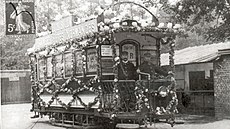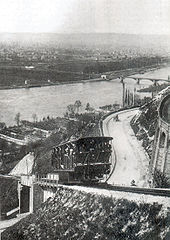Trams in Rouen
The first generation tramway was a tram network built in Rouen, Normandy, northern France, that started service in 1877, and finally closed in 1953.
Horse-drawn carriages and omnibuses had started at the end of the 18th century and progressively improved, but were no longer enough to provide urban services in an age of industrial and demographic growth.
The network spread quickly through various city-centre districts on the right bank of the Seine, to reach the suburbs of the northern plateau, the hills of Bonsecours in the east, skirting around the textile valley of the River Cailly in the west, crossing the river and serving, in the south, the suburbs and industrial districts of the left bank.
At its largest it covered 70 kilometres (43 mi) of route, the longest network in France during the Belle Époque, and contributed to the success of events in the town's history, such as the Colonial Exhibition of 1896 and the Norman Millennium Festival of 1911.
The rising power of buses and trolleybuses, the Great Depression in France, and above all the Second World War that ravaged Rouen and Normandy, condemned the tramway to death.
It prospered during the 19th century, with the traditional trades of textiles and Rouen manufactory (faïence) alongside the newer chemical and papermaking industries.
[2] Urban services — always horse-drawn, either carriages or omnibuses on the most profitable routes — were not enough to satisfy the needs of a town that already numbered, with its suburbs, more than 170,000 people.
[8] The first steam trams of Léon Francq's design soon appeared on the Maromme line and coexisted with the horse-drawn tramways that served the city centre.
[12] Moreover, steam power angered both residents — who accused them of being dirty and rough-riding — and coachmen — whose animals were scared by the driver's horn and the "infernal" noise of the trains.
[13] In 1895 the mediocrity of horse-drawn service and the prospect of the great Colonial Exposition (due to open in Rouen on 1 April 1896) made the town officials think of extension and electrification of the network.
Electrification was contracted to the company of Thomson Houston, who built the "first network", ten lines of standard gauge, either over new or re-laid tracks:[15] Infrastructure works and construction of the power station on the Rue Lemire were swiftly completed.
[17] The dynamism of public transport in Rouen was an inspiration to Baron Empain who, through the intermediary of his colleague Cauderay, proposed the creation of a second complementary network.
This last section, running over the local authority's rails, connected Grand-Quevilly (Rue de l’Église) and, on a branch, the district of Petit-Quevilly (opened 1 August 1915).
It overcame its reduced staffing levels with overtime, abolition of leave, and redeployment of depot personnel; nearly all conductors were promoted to motormen, to their great satisfaction.
[24] To satisfy military requirements, the network extended the Champ de Courses track to the Château du Madrillet, headquarters of an important BEF base.
[29] The tramways continued as going concerns, and started large programmes of renovation and modernisation in the dozen or so years before World War II.
[31] The 1930s also saw the arrival of the trolleybus, having the twin advantages of electrical traction and pneumatic tyres; these newcomers supplanted the old trams on the Mont-Saint-Aignan line from Sotteville and Saint-Étienne-du-Rouvray.
It had been a catastrophe for the network: of the 76 trams in circulation in 1939, 24 had been destroyed and 25 damaged; track and overhead lines had been mutilated; the Trianon depot had been bombed several times[35] Still, service was slowly restored, thanks to the staff's hard work and above all passengers' help in shunting trailing cars.
The 2,200 m (110-chain) line, with a terminus at the Quai de la Bourse, would be served by steam carriages with a capacity of only 30 places, but capable of running on public streets as well as its special track.
In 1892 Bonsecours was finally connected to the "world below" when two Swiss engineers, Ludwig and Schopfer, built a funicular railway with water-filled counterweights.
Line 4 of the CTR, with its central terminus at Place Beauvoisine, ran only as far as the Trianon roundabout at the edge of the Jardin des Plantes.
A southern extension was planned to the Bruyères roundabout, a meeting-point of several roads to the new districts, and to the racecourse where major horse racing events took place each Thursday.
[43] In 1903 a Sotteville man, M. Hulin, the owner and proprietor of the Château des Bruyères, grew tired of these delays and asked for the concession for a 600 mm (1 ft 11+5⁄8 in) narrow gauge horse-drawn tramway, which would connect the Trianon roundabout to the racecourse via the Elbeuf road, being 2,000 m (99 chains) long.
This time for reflection led to abandoning horse-drawn trams in favour of mechanical traction,[44] and moving the terminus from the racecourse entrance to the vast cemetery that the authorities intended to build,[Note 5] close to a shooting range.
[46] This short 2,200 m (110-chain) route, opened solely for passenger traffic, traced a rectangle between the Trianon roundabout and the racecourse, the 600 mm (1 ft 11+5⁄8 in) narrow gauge rails being established beside the Rue d’Elbeuf between the trees lining the road and the fences separating adjacent land (much of which was owned by Hulin).
[44] Service was provided by two 24 hp (18 kW) diesel-electric locomotives, built by the Turgan workshops, each with room for 16 people,[Note 7] and the fuel depot was sited near to the racecourse.
[44] In 1906 a law was passed instituting a weekly day of rest, so it was decided, from 12 January 1907, to extend the line 800 m (40 chains) to the Madrillet roundabout at the edge of the Rouvray Forest, which was popular for Sunday walks.
The same year, diesel-electric locomotives (whose "terrible noise" frightened the horses, to the chagrin of their owners[47]) were replaced[Note 9] by electromotive traction.
[50] The situation so preoccupied the Compagnie du Tramway de Rouen-Trianon that in January 1908 it replaced Hulin, always the driving force, and asked the Conseil Général to authorise a reduction in service frequency.
[52] The railway was officially disbanded by a decree of 14 September 1911,[53] the rails were lifted, the public highway restored; no trace of the tramway remains.















